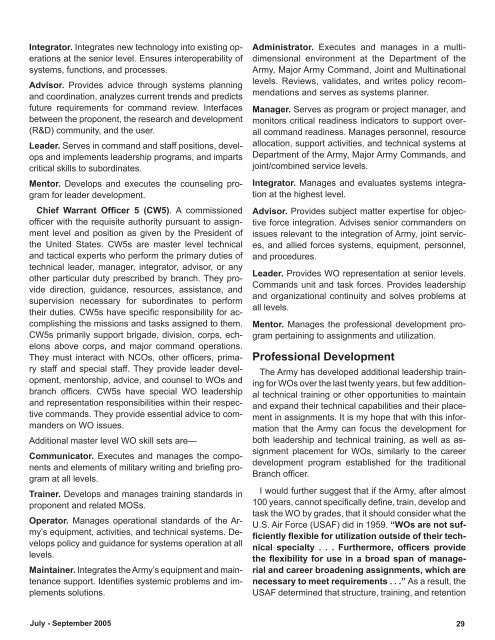Military Intelligence Professional Bulletin - Federation of American ...
Military Intelligence Professional Bulletin - Federation of American ...
Military Intelligence Professional Bulletin - Federation of American ...
Create successful ePaper yourself
Turn your PDF publications into a flip-book with our unique Google optimized e-Paper software.
Integrator. Integrates new technology into existing operations<br />
at the senior level. Ensures interoperability <strong>of</strong><br />
systems, functions, and processes.<br />
Advisor. Provides advice through systems planning<br />
and coordination, analyzes current trends and predicts<br />
future requirements for command review. Interfaces<br />
between the proponent, the research and development<br />
(R&D) community, and the user.<br />
Leader. Serves in command and staff positions, develops<br />
and implements leadership programs, and imparts<br />
critical skills to subordinates.<br />
Mentor. Develops and executes the counseling program<br />
for leader development.<br />
Chief Warrant Officer 5 (CW5). A commissioned<br />
<strong>of</strong>ficer with the requisite authority pursuant to assignment<br />
level and position as given by the President <strong>of</strong><br />
the United States. CW5s are master level technical<br />
and tactical experts who perform the primary duties <strong>of</strong><br />
technical leader, manager, integrator, advisor, or any<br />
other particular duty prescribed by branch. They provide<br />
direction, guidance, resources, assistance, and<br />
supervision necessary for subordinates to perform<br />
their duties. CW5s have specific responsibility for accomplishing<br />
the missions and tasks assigned to them.<br />
CW5s primarily support brigade, division, corps, echelons<br />
above corps, and major command operations.<br />
They must interact with NCOs, other <strong>of</strong>ficers, primary<br />
staff and special staff. They provide leader development,<br />
mentorship, advice, and counsel to WOs and<br />
branch <strong>of</strong>ficers. CW5s have special WO leadership<br />
and representation responsibilities within their respective<br />
commands. They provide essential advice to commanders<br />
on WO issues.<br />
Additional master level WO skill sets are—<br />
Communicator. Executes and manages the components<br />
and elements <strong>of</strong> military writing and briefing program<br />
at all levels.<br />
Trainer. Develops and manages training standards in<br />
proponent and related MOSs.<br />
Operator. Manages operational standards <strong>of</strong> the Army’s<br />
equipment, activities, and technical systems. Develops<br />
policy and guidance for systems operation at all<br />
levels.<br />
Maintainer. Integrates the Army’s equipment and maintenance<br />
support. Identifies systemic problems and implements<br />
solutions.<br />
Administrator. Executes and manages in a multidimensional<br />
environment at the Department <strong>of</strong> the<br />
Army, Major Army Command, Joint and Multinational<br />
levels. Reviews, validates, and writes policy recommendations<br />
and serves as systems planner.<br />
Manager. Serves as program or project manager, and<br />
monitors critical readiness indicators to support overall<br />
command readiness. Manages personnel, resource<br />
allocation, support activities, and technical systems at<br />
Department <strong>of</strong> the Army, Major Army Commands, and<br />
joint/combined service levels.<br />
Integrator. Manages and evaluates systems integration<br />
at the highest level.<br />
Advisor. Provides subject matter expertise for objective<br />
force integration. Advises senior commanders on<br />
issues relevant to the integration <strong>of</strong> Army, joint services,<br />
and allied forces systems, equipment, personnel,<br />
and procedures.<br />
Leader. Provides WO representation at senior levels.<br />
Commands unit and task forces. Provides leadership<br />
and organizational continuity and solves problems at<br />
all levels.<br />
Mentor. Manages the pr<strong>of</strong>essional development program<br />
pertaining to assignments and utilization.<br />
<strong>Pr<strong>of</strong>essional</strong> Development<br />
The Army has developed additional leadership training<br />
for WOs over the last twenty years, but few additional<br />
technical training or other opportunities to maintain<br />
and expand their technical capabilities and their placement<br />
in assignments. It is my hope that with this information<br />
that the Army can focus the development for<br />
both leadership and technical training, as well as assignment<br />
placement for WOs, similarly to the career<br />
development program established for the traditional<br />
Branch <strong>of</strong>ficer.<br />
I would further suggest that if the Army, after almost<br />
100 years, cannot specifically define, train, develop and<br />
task the WO by grades, that it should consider what the<br />
U.S. Air Force (USAF) did in 1959. “WOs are not sufficiently<br />
flexible for utilization outside <strong>of</strong> their technical<br />
specialty . . . Furthermore, <strong>of</strong>ficers provide<br />
the flexibility for use in a broad span <strong>of</strong> managerial<br />
and career broadening assignments, which are<br />
necessary to meet requirements . . .” As a result, the<br />
USAF determined that structure, training, and retention<br />
July - September 2005 29
















